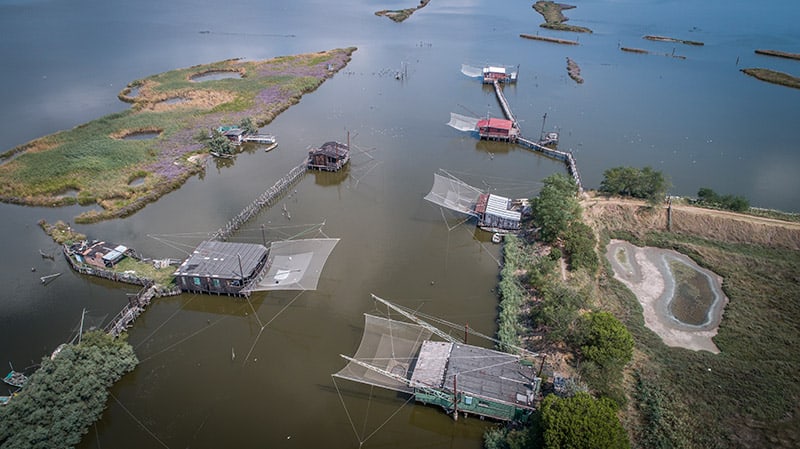Comacchio e le sue Valli

La leggenda racconta che l’antico nucleo di Comacchio, la piccola Venezia, sorgesse su 13 isolette, collegate tra di loro da numerosi ponti.
Le Valli di Comacchio, situate a Comacchio ed estendendosi sino alla provincia di Ravenna, costituiscono una vasta area verde di 11000 ettari, caratterizzata da quattro valli principali (Lido di Magnavacca, Fossa di Porto, Campo e Fattibello) e dall’elevata presenza di animali, uccelli in particolare. Nella zona di Comacchio è molto attiva la pesca alle anguille.
Il più famoso è Treponti, emblema della cittadina, disegnato e realizzato da Luca Danese nella prima metà del XVII secolo; è costituito da 5 ampie scalinate che culminano in un rialzo di pietra d’Istria.
Un piccolo centro che nasce e che vive tra la terra e l’acqua e l’orgoglio di una comunità che è stata in grado di sopravvivere ad una natura spesso dura, un passato che si respira ancora tra le eleganti strade e i tranquilli canali. Comacchio è immersa nelle Valli, oggi museo all’aperto, si prosegue lungo le sue spiagge e il calendario è denso di manifestazioni, fiere ed eventi.
La città di Comacchio e le sue valli rappresentano il “cuore” del Delta ,sono di fatto il polmone verde dell’intera costa adriatica da Chioggia a Cattolica. Le Valli di Comacchio sono il vero museo e rappresentano uno dei più importanti complessi lagunari esistenti in Italia ed in Europa. Si estendono nelle province di Ferrara e in parte di Ravenna, per più di 11.000 ettari, tra Comacchio e il fiume Reno, e sono collegate al mare tramite i canali di Magnavacca, Logonovo, Bellocchio e Gobbino. Formate da acqua salmastra dalla salinità molto accentuata: rappresentano un importante biotopo di zona umida ad acqua salmastra, costituito da vegetazione estrema alofita e dichiarato di interesse internazionale, in base alla convenzione di Ramsar del 1971.
Intorno alle valli si è incentrata e sviluppata la vicenda storica ed economica del territorio di Comacchio; si tratta di un esempio pressoché unico di integrazione tra l’ambiente naturale e l’attività dell’uomo, dove la produzione del sale e la pesca hanno sempre rappresentato le basi economiche primarie, alle quali era prevalentemente legato l’artigianato locale, essendo quasi assente l’agricoltura e mancando completamente il turismo. Queste ultime componenti economiche si sono sviluppate quasi contemporaneamente con l’affermarsi della bonifica ed il prosciugamento di migliaia di ettari di valle, lasciandone inalterata quella parte dove ancora oggi si pratica soprattutto la pesca tipica all’anguilla con particolari strumenti chiamati lavorieri.
La superficie totale è formata dalle valli Fossa di Porto (comprendente l’oasi di Zavelea), Lido di Magnavacca, Fattibello (che nel passato anche non lontano veniva usata per la pesca a titolo di sostentamento quotidiano) e Campo; presenta una morfologia articolata a causa:
delle arginature artificiali create per delimitare i bacini di pesca della presenza di dossi, barene e antichi cordoni dunosi emergenti dalle acque.
La Penisola di Boscoforte è una lingua di sabbia molto suggestiva, si protende dall’argine del fiume Reno tra le valli Fossa di Porto e Lido di Magnavacca per una lunghezza di 6 km, formatasi dall’affioramento di un cordone dunoso-litoraneo di epoca etrusca.
Museo vivo: per le piante, gli uccelli, i dossi, i casoni, per i pescatori che vi si incontrano, per le memorie di un antica vicenda, portando col vento l’eco del passato.
Originatesi intorno al X secolo, a causa dei fenomeni di abbassamento del suolo (subsidenza) e di impaludamento della zona costiera, si estendevano per una superficie di 73.000 ettari. Inizialmente erano valli di acqua dolce, formatesi dalle alluvioni dei fiumi. A partire dal secolo XVI s’aggiunse l’ingressione delle acque marine, che crearono la definitiva valle salmastra. Tra gli argini e i dossi si scorgevano innumerevoli casoni e tabarre, che in origine erano costruiti in canna e paglia, ma che tra il XVII e XVIII secolo furono abbattuti e rifatti in muratura.
Alla fine dell’Ottocento erano attive più di 70 costruzioni che oggi, a seguito delle distruzioni belliche e delle grandi bonifiche, sono ridotte a 5 stazioni per la pesca e 7 case di vigilanza funzionanti.
Ai visitatori l’invito a leggere il dramma plurisecolare di questo mondo fatto d’acque nei casoni ,nelle tabarre ,nelle cavanne ,nelle barche ,negli attrezzi per la pesca ,nelle suppellettili della quotidianità dei vallanti ,un tempo vincolati alle valli come servi della

